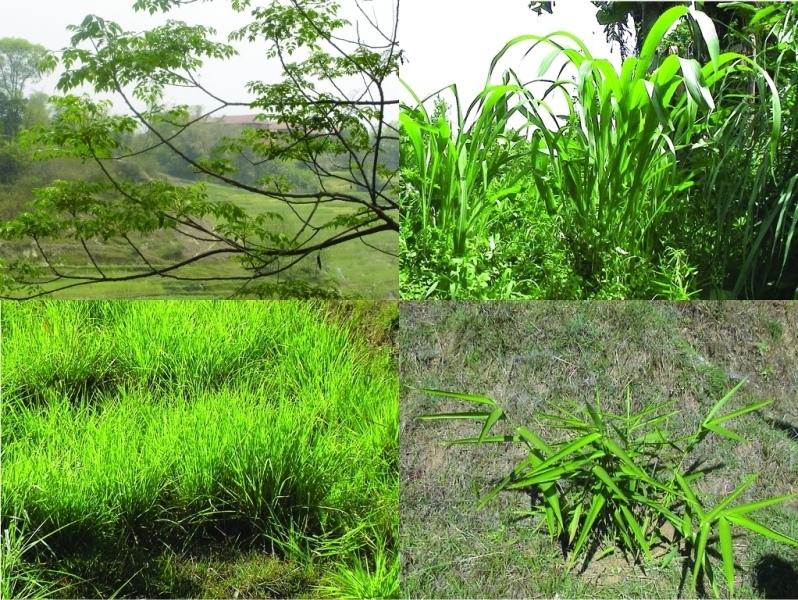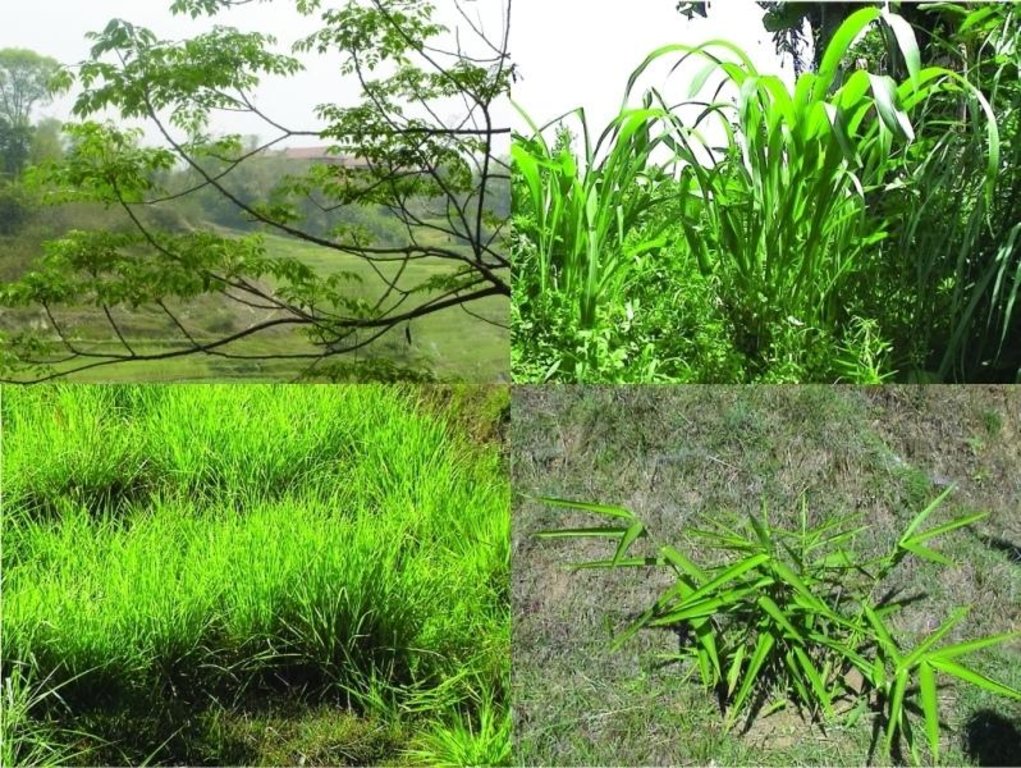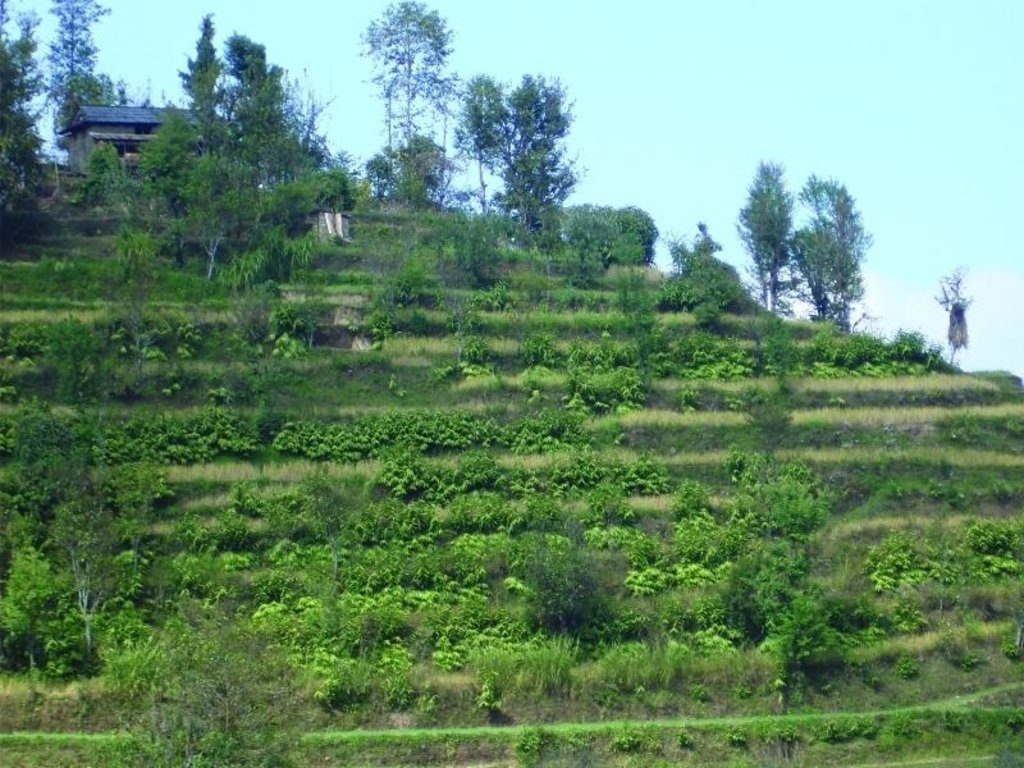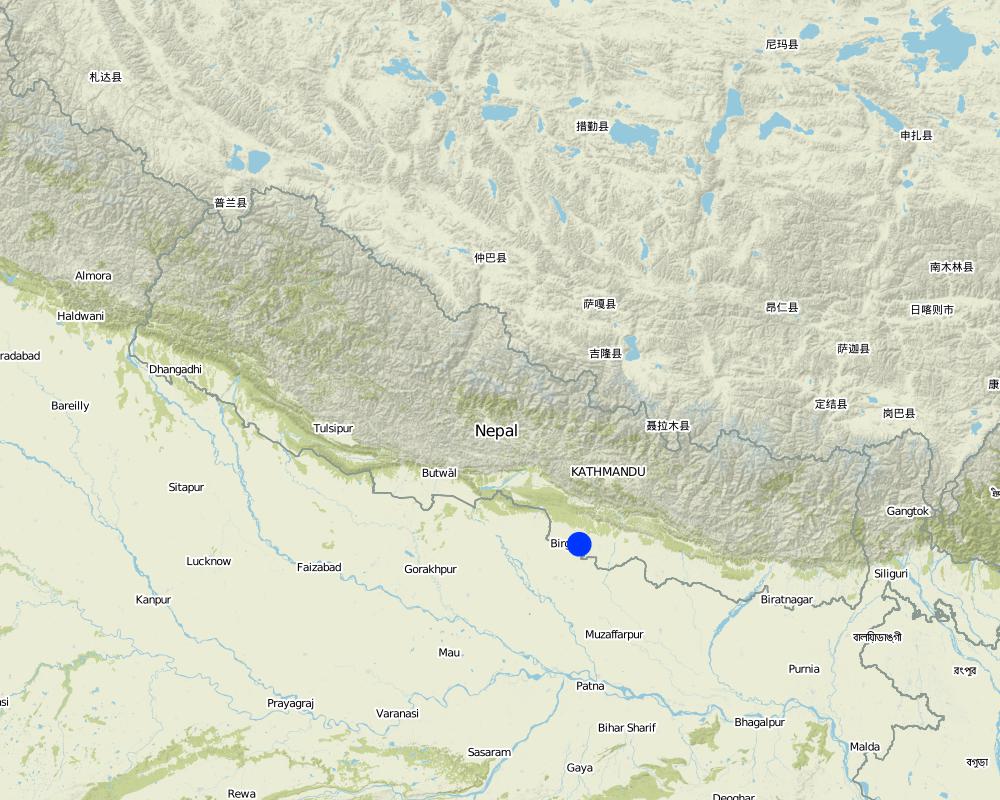Cultivation of fodder and grasses [尼泊尔]
- 创建:
- 更新:
- 编制者: Richard Allen
- 编辑者: –
- 审查者: David Streiff, Alexandra Gavilano
Dale ghans tatha bhuin ghans prawardhan
technologies_1757 - 尼泊尔
查看章节
全部展开 全部收起1. 一般信息
1.2 参与该技术评估和文件编制的资源人员和机构的联系方式
SLM专业人员:
Director
Soil Management Directorate, Department of Agriculture
尼泊尔
SLM专业人员:
Team Leader
Sustainable Soil Management Programme
尼泊尔
有助于对技术进行记录/评估的项目名称(如相关)
Sustainable Soil Management Programme, Nepal (SSMP)有助于对技术进行记录/评估的机构名称(如相关)
Department of Agriculture, Soil Management Directorate, Hariharbhawan Lalitpur (doasoil) - 尼泊尔有助于对技术进行记录/评估的机构名称(如相关)
HELVETAS (Swiss Intercooperation)1.3 关于使用通过WOCAT记录的数据的条件
编制者和关键资源人员接受有关使用通过WOCAT记录数据的条件。:
是
1.5 参考关于SLM方法(使用WOCAT记录的SLM方法)的调查问卷

Farmer field schools on integrated plant nutrient systems [尼泊尔]
Participatory and collaborative learning through the farmer field school approach
- 编制者: Richard Allen

Farmer-to-farmer diffusion [尼泊尔]
Wider diffusion of sustainable soil management technologies through a demand responsive farmer-to-farmer diffusion approach
- 编制者: Richard Allen
2. SLM技术的说明
2.1 技术简介
技术定义:
Cultivation of fodder crops on marginal lands and terrace risers
2.2 技术的详细说明
说明:
Fodder plays a major role in the crop-livestock-manure-soil nutrient cycle on farms in the middle mountains of the Himalayas. Livestock convert fodder shrubs and grasses from the forest, crop residues, and other fodder into manure through digestion. However, in the middle hills of Nepal the lack of availability of good quality fodder often limits not only, the productivity of livestock, but also reduces the nitrogen content of animal dung if, for example, only cereal crop residues, are fed to the animals.
In earlier times, livestock were left to graze in the forests and on community lands. The animals sought out their own food and were only assembled for milking and to protect them from wild animals. With the introduction of stall-feeding, the demand for fodder has increased greatly with a subsequent large increase in women’s workload as it is they who are responsible for collecting the fodder.
Most fodder is collected in forest areas, and most livestock manure is applied to arable land, in particular to rainfed fields. This results in a net transfer of nutrients from forest areas to arable lands. It is estimated that, in this way, about 3 to 7 ha of forest land is needed to maintain 1 ha of arable land without degrading the state of the forest. In addition to reducing the availability of forest resources, the widespread closure of community forests has diminished access to fodder during certain times of the year. All this is putting serious pressure on the remaining unprotected forest resources.
Marginal lands and terrace risers offer an opportunity to reduce this pressure. The planting of grasses and shrubs suitable for fodder on these areas not only increases fodder availability but also reduces erosion and landslides that originate in these areas. If leguminous fodder species are planted, they increase soil fertility by increasing the nitrogen content in soils.
2.3 技术照片
2.5 已应用该技术的、本评估所涵盖的国家/地区/地点
国家:
尼泊尔
具体说明该技术的分布:
- 均匀地分布在一个区域
Map
×3. SLM技术的分类
3.1 该技术的主要目的
- 改良生产
- 减少、预防、恢复土地退化
3.2 应用该技术的当前土地利用类型

农田
- 一年一作
年作 - 具体指明作物:
- 饲料作物 - 草
- 饲料作物 - 其他
注释:
Major land use problems (compiler’s opinion): Increasing livestock numbers causing the degradation of unprotected forest areas. The closure of large areas of community managed forests to grazing and fodder collection is putting more pressure on unprotected forest areas and increasing the demand for alternative sources of fodder and better quality fodder.
3.5 该技术所属的SLM组
- 农畜综合管理
- 改良的地面/植被覆盖
3.6 包含该技术的可持续土地管理措施

植物措施
- V2:草和多年生草本植物
3.7 该技术强调的主要土地退化类型

化学性土壤退化
- Cn:肥力下降和有机质含量下降(非侵蚀所致)
3.8 防止、减少或恢复土地退化
具体数量名该技术与土地退化有关的目标:
- 减少土地退化
4. 技术规范、实施活动、投入和成本
4.1 该技术的技术图纸
技术规范(与技术图纸相关):
Technical knowledge required for field staff / advisors: low
Technical knowledge required for land users: low
Main technical functions: increased availability of fodder, improved manure quality & increased quantity of manure, increased soil fertility
Secondary technical functions: nitrogen fixation (if leguminous species are planted)
Trees/ shrubs species: badahar (Artocarpus lakoocha), dudhilo (Ficus nemoralis), nemaro (Ficus roxburghi), tank (Bauhinia p
Grass species: stylo (Stylosanthes spp.), dinanath (Penisetum spp.), molasses, Napier grass NB21 (Penisetum purpure)
4.2 有关投入和成本计算的一般信息
具体说明成本计算所用货币:
- 美元
注明雇用劳工的每日平均工资成本:
2.00
4.3 技术建立活动
| 活动 | 时间(季度) | |
|---|---|---|
| 1. | Establish nursery for saplings/seedlings, and procure seed of appropriate species | |
| 2. | Transplant at appropriate time on wasteland areas around houses and terrace risers as given in the Agroforestry Training Manual (NAF, SSMP 2002) |
4.4 技术建立所需要的费用和投入
| 对投入进行具体说明 | 单位 | 数量 | 单位成本 | 每项投入的总成本 | 土地使用者承担的成本% | |
|---|---|---|---|---|---|---|
| 劳动力 | Nursing seedling | Persons/day | 3.0 | 2.0 | 6.0 | 100.0 |
| 植物材料 | Seedlings | unit | 1.0 | 4.0 | 4.0 | 100.0 |
| 技术建立所需总成本 | 10.0 | |||||
| 技术建立总成本,美元 | 10.0 | |||||
4.5 维护/经常性活动
| 活动 | 时间/频率 | |
|---|---|---|
| 1. | Depending on species, newly established trees and shrubs need to be pruned, pollarded, or coppiced; grasses need no further agronomic practices | |
| 2. | Replace dead plants and ones that failed to establish |
4.6 维护/经常性活动所需要的费用和投入(每年)
| 对投入进行具体说明 | 单位 | 数量 | 单位成本 | 每项投入的总成本 | 土地使用者承担的成本% | |
|---|---|---|---|---|---|---|
| 劳动力 | Replace dead plants | Persons/day | 3.0 | 2.0 | 6.0 | 100.0 |
| 技术维护所需总成本 | 6.0 | |||||
| 技术维护总成本,美元 | 6.0 | |||||
注释:
Cost as in January 2007
4.7 影响成本的最重要因素
描述影响成本的最决定性因素:
Cost ofseeds or saplings/seedlings depends on species.
5. 自然和人文环境
5.1 气候
年降雨量
- < 250毫米
- 251-500毫米
- 501-750毫米
- 751-1,000毫米
- 1,001-1,500毫米
- 1,501-2,000毫米
- 2,001-3,000毫米
- 3,001-4,000毫米
- > 4,000毫米
有关降雨的规范/注释:
Annual rainfall: Also 2000-3000 mm
农业气候带
- 潮湿的
Thermal climate class: subtropics
5.2 地形
平均坡度:
- 水平(0-2%)
- 缓降(3-5%)
- 平缓(6-10%)
- 滚坡(11-15%)
- 崎岖(16-30%)
- 陡峭(31-60%)
- 非常陡峭(>60%)
地形:
- 高原/平原
- 山脊
- 山坡
- 山地斜坡
- 麓坡
- 谷底
垂直分布带:
- 0-100 m a.s.l.
- 101-500 m a.s.l.
- 501-1,000 m a.s.l.
- 1,001-1,500 m a.s.l.
- 1,501-2,000 m a.s.l.
- 2,001-2,500 m a.s.l.
- 2,501-3,000 m a.s.l.
- 3,001-4,000 m a.s.l.
- > 4,000 m a.s.l.
关于地形的注释和进一步规范:
Slopes on average: Also moderate (6-10%), rolling (11-15%) and hilly (16-30%)
Landforms: Also footslopes
Altitudinal zone: Also 1000-1500 m a.s.l. and 1500-2000 m a.s.l.
5.6 应用该技术的土地使用者的特征
生产系统的市场定位:
- 生计(自给)
- 商业/市场
个人或集体:
- 个人/家庭
说明土地使用者的其他有关特征:
Off-farm income specification: In most farm households, off-farm income plays at least a minor and increasingly a major role. Occasional opportunities for off-farm income present themselves in the form of daily labour wages. Some households’ members receive regular salaries, whilst an increasing number of Nepalis are working in India, the Middle East, Malaysia, and elsewhere and sending remittance incomes home.
5.7 应用该技术的土地使用者使用的平均土地面积
- < 0.5 公顷
- 0.5-1 公顷
- 1-2 公顷
- 2-5公顷
- 5-15公顷
- 15-50公顷
- 50-100公顷
- 100-500公顷
- 500-1,000公顷
- 1,000-10,000公顷
- > 10,000公顷
5.8 土地所有权、土地使用权和水使用权
土地所有权:
- 个人,未命名
- 个人,有命名
土地使用权:
- 租赁
- 个人
注释:
sharecropping between owner and tenant
6. 影响和结论性说明
6.1 该技术的现场影响
社会经济效应
生产
作物生产
注释/具体说明:
due to shading effect
饲料生产
饲料质量
收入和成本
工作量
注释/具体说明:
mainly for women
其它社会经济效应
milk production
livestock health
manure availability
生态影响
生物多样性:植被、动物
害虫/疾病控制
注释/具体说明:
some of the new species provide inputs for organic pest management
其它生态影响
erosion from terrace bunds and marginal lands
need for free grazing
incidence of rodents and snakes
6.2 该技术的场外影响已经显现
pressure on forest resources
6.4 成本效益分析
技术收益与技术建立成本相比如何(从土地使用者的角度看)?
短期回报:
积极
长期回报:
积极
技术收益与技术维护成本/经常性成本相比如何(从土地使用者的角度看)?
短期回报:
积极
长期回报:
积极
6.5 技术采用
在所有采用这项技术的人当中,有多少人是自发的,即未获得任何物质奖励/付款?:
- 51-90%
注释:
Comments on spontaneous adoption: 80% of the Sfarmers exposed to this technology by SSMP adopted it. 30% farmers with or without direct reference to fodder promotion) have planted a variety of new fodder species About 10% of local farmers not involved in SSMP have adopted the technology.
6.7 该技术的优点/长处/机会
| 编制者或其他关键资源人员认为的长处/优势/机会 |
|---|
| Improves fodder quantity and quality with a positive impact on livestock health and productivity |
| Increased fodder availability near the house reduces the workload of women to collect fodder and grass for livestock |
| Feeding of improved fodder and grasses improves quality of farmyard manure and thereby reduces need for mineral fertilise |
| Different species provide source of mulching and staking material |
6.8 技术的弱点/缺点/风险及其克服方法
| 编制者或其他关键资源人员认为的弱点/缺点/风险 | 如何克服它们? |
|---|---|
| In places fodder grasses and shrubs have increased the incidence of rodents and snakes | select appropriate species; pruning and pollarding to manage height of the plants |
| Shading effect on fi eld crops | only plant such species on wastelands or along river banks |
| Host of insect pests | |
| Some species (e.g. bamboo, eucalyptus) have alleopathic effects that inhibit the growth of crop and other plants |
7. 参考和链接
7.1 信息的方法/来源
7.2 参考可用出版物
标题、作者、年份、ISBN:
NAF; SSMP (2002) Agroforestry Training Manual (in Nepali). Kathmandu: Nepal Agroforestry Foundation and Sustainable Soil Management Programme
可以从哪里获得?成本如何?
SSMP
链接和模块
全部展开 全部收起链接

Farmer field schools on integrated plant nutrient systems [尼泊尔]
Participatory and collaborative learning through the farmer field school approach
- 编制者: Richard Allen

Farmer-to-farmer diffusion [尼泊尔]
Wider diffusion of sustainable soil management technologies through a demand responsive farmer-to-farmer diffusion approach
- 编制者: Richard Allen
模块
无模块





